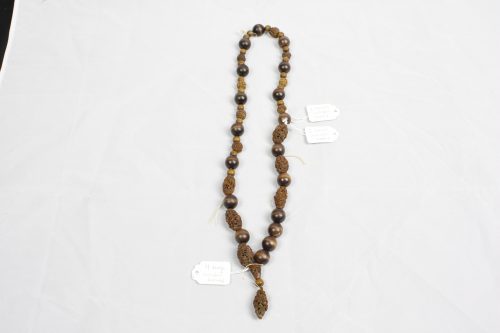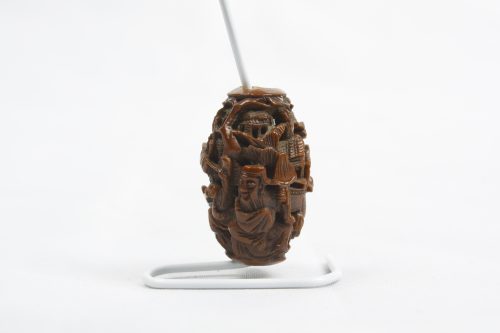Over the course of the past several months that I’ve spent photographing artifacts at the museum, I’ve been lucky to get the perspectives of several different Huron County Museum staff members to see how they encounter objects and their narratives. Below are a selection of responses from interviews with Curator Elizabeth French-Gibson, Archivist Jenna Leifso, Registrar Patti Lamb, and Museum Technician Heidi Zoethout.
Do you have a favourite artifact/archival document at the museum (either on display or in storage)? If so, could you describe why?
Jenna Leifso (Archivist): I really enjoy the photograph collection and couldn’t pick just one photo because every time I catalogue a new collection or look through the photos I find something that delights me. The facial expressions, the clothes, and the hair are all really incredible.
Elizabeth French-Gibson (Curator): My favourite artifacts are the textiles, primarily the clothing. I look at each piece and wonder about the person who wore it – why did they have it & why did they save it? I am curious to know what other clothes they had and wore out, had and ruined or simply had and didn’t think were significant enough to save. We have many pieces in the collection that are the fancy dress, wedding attire, baby clothing, etc. that are beautiful and special but what about the everyday? What did they chose to simply wear and what to wear out?
Patti Lamb (Registrar): So many of our artifacts tell really cool stories, it’s hard to pick out just one. But my favourite artifact has to be Tiger Dunlop’s silver cup with the gold sovereign in it. We just received it a few months ago. It is so incredible to me to be able to hold in my hands the same silver cup that Tiger Dunlop drank from…someone that was so significant politically to Goderich, the county, our county and the world. The cup was willed to his sister in his quirky will.

Beaded necklace: 1957.10.3. Photo from Huron County Museum’s catalogue.
Heidi Zoethout (Museum Technician): I have a few favourites, right now the top of the list is the carved beaded necklace. The detail in the larger beads is amazing. I did not realize that some beads are carved fruit pits. Something that is normally discarded that can be made into something so beautiful.

Close-up of carved bead.
.
What is your perception of artifacts? What place and value do you think they have in society to-day?
Jenna Leifso (Archivist): I think I may have a different perception of artifacts than most people. Growing up, my family always went to museums and historical villages. I think it’s cool to see how we have evolved and how we are always trying to constantly improve.
Elizabeth French-Gibson (Curator): I think that artifacts provide us with a tangible connection with the past. It is necessary to have all types of artifacts available to the public in order to have a better view of the past. It would be easy to change the story, or overlook the mundane if the true pieces were not there. Each artifact has the ability to tell a story but the storyteller must be open to what it is truly saying.
Patti Lamb (Registrar): The artifacts create ties with the past and gives history a visual component. In such a disposable world in which we live, I think it’s important to be able to physically see and possibly touch items from the past.
Heidi Zoethout (Museum Technician): Some people look at an artifact and imagine who would have used it and create a scene in their mind. When I am working with an artifact, I think about the work and thought that went into its creation. Some designs have not changed much over time while others can be seen evolving through the collection we have.Through artifacts we are able to see how our thoughts and values have changed over time as a society and where they have not. It is a common refrain when staff are moving large objects that “they don’t make them like that anymore”. From the materials used, the amount of material used and the details that have gone into producing the product. An example of this is a bicycle that I was preparing for exhibit. It had many grease fittings which we no longer require on bicycles and the rims were made from wood. The wood had been lacquered and pin striping had been applied. When I finished working with the bicycle I came to appreciate it as work of art rather than a mode of transportation.
What would your dream project be? (e.g curating a certain type of exhibition, working with a certain set of artifacts, researching a particular area, etc.)
Jenna Leifso (Archivist): One of my dream projects would be exploring how Huron County residents acquired their clothes. I think there is a misconception that rural citizens were out of fashion and that everything was homemade, drab and boring. It would be interesting to have an exhibit that looks at the clothing factories that used to be here, mail order catalogues like Eatons and Simpsons, and how residents were influenced by fashions overseas. I would use photographs, newspaper advertisements, local directories, maps, correspondence, diary entries, and of course, clothes that are in the collection to research and create this exhibit.
Elizabeth French-Gibson (Curator): I would like to be able to spend more time on research for the Gaol. I think there are resources out there that we have not found yet and the resources that we have that have not been given the focus yet. It would be interesting for me to be able to learn more about the circumstances and lives of the people who spent time in our Gaol, as well as the functions and habits of the Gaol itself.
Patti Lamb (Registrar): My dream project would be anything related to glass or to be able to spend a greater amount of time on the Huron Pottery exhibit and the archeological collection.
Heidi Zoethout (Museum Technician): Currently my dream project would be organizing offsite storage so we could have tours available to the public. There are many details and much work required to make that possible.
Overall, throughout this project one of the most valuable experiences has been hearing the varying perspectives on museums, exhibit design, and artifacts, from such a knowledgeable and unique staff. The differing responses speak to how each of us experiences artifacts and their narratives differently according to our own lived experiences.
The artistic exhibition of photographs taken during this project will be on display in St. Catharines at the Marilyn I. Walker School of Fine and Performing Arts from April 11th – May 5th with an opening reception to be held on April 13th from 5-7pm.

